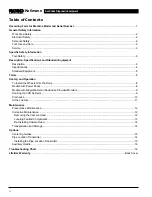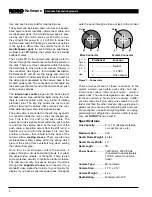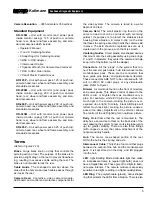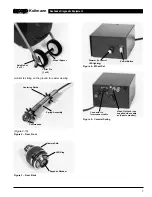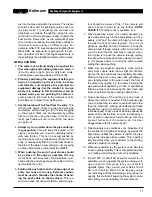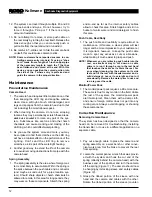
ary into the pipe and watch the monitor. The picture
should be clear and the lighting should be even on
the pipe walls. Try adjusting the contrast and
brightness, as well as the lighting (using the dim-
mer knob on the monitor/power pack) to obtain the
best picture. Remember, as the materials of pipe
vary, it will be necessary to adjust these settings to
maximize picture quality on different jobs. For
example, white PVC pipe requires less lighting than
Black ABS. As experience is gained with the sys-
tem, operators will learn that slight adjustments in
these settings can highlight problems within a pipe.
At the Job Site
1. The camera can almost always be pushed far-
ther when grip-style rubber gloves are worn. It
is much easier to get a grip on dirty push cable,
and the gloves also keep sludge off the hands.
2. Properly positioning the equipment before you
begin an inspection will save time, be more
comfortable, and minimize the potential for
equipment damage. Set the monitor in an area
where it is unlikely to fall, and where it can be
viewed while you are pushing the camera. A
good location is right next to the cleanout or entry
point. Be sure to keep it from getting wet.
3. Set the reel about 6 to 8 feet from the entry. This
will provide ample cable to grasp and develop
momentum without having a lot of slack dragging
on the ground. Slack can be alleviated by putting
friction on the reel using the brake. If it is set cor-
rectly, push cable will only come off the reel when
you pull on it.
4. Always try to run water down the pipe undergo-
ing inspection. This will keep the system much
cleaner, and allow you to push noticeably farther
with less friction. This can be accomplished by
feeding a hose with a small amount of flow into the
entry or occasionally flushing a toilet that drains to
the pipe. If the water is preventing you from seeing
an area of importance, temporarily turn it OFF.
5. When pushing, the end of your stroke should
be as close to the entry as possible. Standing
too far back, with an excess of cable between your
hands and the entry may cause the cable to fold on
itself outside the entry.
6. Folding the push cable on the sharp edge of an
entry can cause it to snap. Extreme caution
must be used to minimize the chance of bend-
ing the push cable on sharp corners. This is a
common cause of push cable failure, and all opera-
tors should be aware of this. If the camera just
doesn’t seem to want to go any farther, DON’T
FORCE IT! If another entry is available, try it.
7. When inspecting a pipe, it is usually necessary to
give a little extra push in the bends. Back up, if nec-
essary, and “pop” the camera through a turn using
the least amount of force required. Try to be as
gentle as possible, and don’t hammer or snap the
camera head through corners. After some practice,
you may learn that the best way to inspect a sec-
tion of pipe is to push the camera through quickly,
then draw the camera back home slowly and even-
ly. It is always easier to control the camera when
pulling than when pushing.
8. Make sure the sapphire window is clean prior to
entry. Some users claim that a slight film of deter-
gent on the lens minimizes the possibility of grease
sticking to the port. In any case, take advantage of
any standing water in the pipe to wash the front of
the camera by jiggling it in the water. Flushing the
pipe with water supplied by a hose or periodically
flushing a toilet can help keep the port clean and
improve performance by reducing cable friction.
9. Take advantage of the lighting to keep track of
where the camera is headed. If the particular pipe
you are inspecting is easier to evaluate with other
than the maximum lighting, periodically maximize
the lighting (using the dimmer knob on the moni-
tor/power pack) to get a look at what lies ahead. Be
aware of any obstructions, such as a crushed sec-
tion of pipe or excessive hard build-up, that may
prevent retrieval of the camera. do not clear
clogged lines with the camera head!
9. Pipe materials and conditions vary. Adjustment of
the contrast and brightness settings, as well as the
light dimmer after the camera is within the pipe,
can greatly increase picture quality. This is particu-
larly important when your customer is supervising,
and when making recordings.
10. Whenever possible, lay the system on its side feet
for even greater stability. This is also preferred when
on a rooftop (entry through a roof vent) or hillside.
11. If local 120V (or 230V) AC power for monitor is not
available, you can operate the system using a volt-
age converter that plugs into your vehicle’s
cigarette lighter. They convert your vehicles 12 volt
DC to 120 volts (or 230V) AC. As long as you are
not rewinding and fast-forwarding video tapes fre-
quently, this method of powering the system can be
done safely on a good battery for several hours.
SeeSnake Diagnostic Equipment
Kollmann
11


